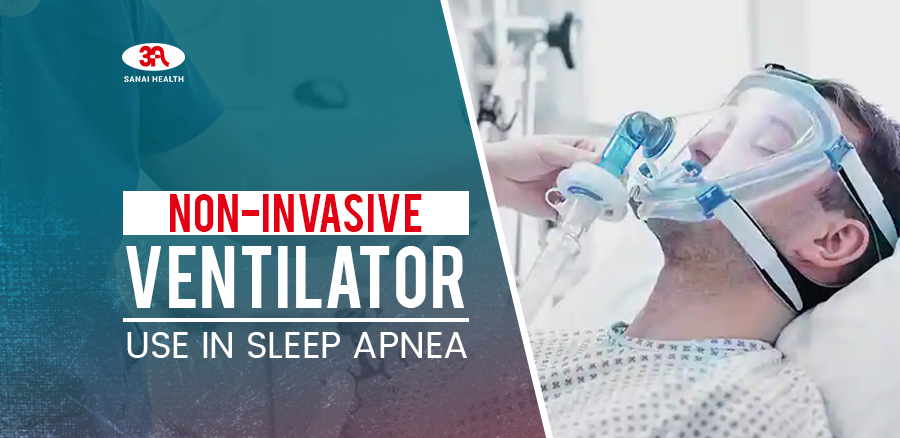How Does a Non-Invasive Ventilator Help With Sleep Apnea?
What is Sleep Apnea?
Your body needs oxygen constantly without any breaks however there are conditions when the body might be unable to get oxygen. Sleep apnea is a state where a person suddenly stops breathing while they are asleep. The breathing resumes on its own but this sudden stop in breathing can negatively impact the health of the body.
This health condition has been associated with atrial fibrillation and sudden cardiac death. These people are highly susceptible to severe forms of respiratory issues.
Sleep apnea can be of one of two types:
- Central Sleep Apnea: Your brain is in the middle of this apnea as the brain stops telling the chest muscles and air passages to keep on working.
- Obstructive Sleep Apnea: This type of apnea happens as a result of the blocking of the upper airway. This air passageway blocking might be caused by tonsils, tongue, obesity, and even hormonal influence.
CPAP Machines for Sleep Apnea Treatment
Sleep apnea treatment usually comprises a CPAP machine used every night. This treatment is useful in both types of sleep apnea.
How is the CPAP Machine Working?
The CPAP machine provides continuous positive airway pressure to the patient throughout the night.
The pressurized air comes from the environment and is maintained throughout the time that a patient uses the machine. The device aims to keep the pressure maintained enough that the alveoli do not collapse. Collapsed alveolus means that there will be no means for oxygen absorption.
The CPAP machines also have positive end-expiration pressure (PEEP). This means that the machine while maintaining the constant pressure during the breathing cycle (inhalation and exhalation) also makes sure that the pressure at the end of expiration is not low enough to promote the collapse of the alveoli.
PEEP function helps with the following:
- Keeping the alveolus open at the end of the expiration of air.
- Allowing the alveolus to stay open and absorb the inhaled oxygen into the body.
CPAP machines are also called non-invasive ventilators because they help individuals breathe when they are unable to do so.
The Types of CPAP Machines Available in the Market
There are a few varieties of CPAP machines that are different just because of the difference in timings of air pressure increase and decrease.
- Automatic CPAP: This type of CPAP machine is constantly adjusting to airway changes. The pressure keeps on regulating itself to keep the alveoli open for oxygen absorption.
- BiPAP: This CPAP machine differs in the timing of the pressure changes. The device sends in different air pressure at the time of inhalation and then the pressure changes again when the person exhales.
- Adapto servo-ventilation (ASV): Utilized in the cases of patients that have central sleep apnea issues. This machine works by pushing the body to take a breath every time the machine understands that the user isn’t breathing properly.
Multiple Ways to Hook Yourself With the CPAP Machine
Numerous ways can be utilized to deliver constant air pressure to the patient throughout the night.
-Full Face Mask: This mask covers your nose and mouth. This makes sure that the air pressure impacts both types of patients, those who breathe with their mouths open and those who keep them closed.
-Nasal Mask: This mask only covers the nose. The important thing to remember in this case is that the person can easily use their mouth for eating, drinking, and spitting.
Sleep Study to Diagnose Sleep Apnea
You cannot start using a CPAP machine on your own without a doctor prescribing you this treatment option. You will need to have a sleep study done before a confirmed diagnosis is given.
A sleep study is a name given to Polysomnography. Polysomnography is done at a sleep center, a hospital, a lab, or even at home. This testing allows the patient to be observed overnight by skilled technicians.
You will visit the sleep center/hospital and stay overnight for observation. The technicians will observe your body’s readings the whole night. How will they do that? Through sensors.
The technicians will simply attach sensors to different points of your body. Once the sensors have been attached, you are allowed to fall asleep. The technicians will now monitor the oxygen levels in your blood. Other observations include your breathing rate, heart rate, brain waves, and eye movements. Apart from these mentioned parameters, the technicians will also observe your movements in REM sleep.
It is important to remember that several things can cause sleep disorders. Sleep study helps rule out the different sleep disorders and the lab can then pinpoint that it is sleep apnea that’s causing your sleep disturbance.
CPAP and BiPAP Machine Use During Sleep Study
The patients are often told to start using the CPAP or BiPAP machine in advance of the sleep study. The technicians might end up using one of the two machines to see whether the sleep apnea improves with their application. Some people cannot tolerate continuous positive air pressure and so BiPAP is used for them. Once the sleep study is completed, you can go home and live your life as you did before. Your doctor will contact you for an appointment and then you will get your prescription for the CPAP machine or the BiPAP machine.
Non-Invasive Ventilators with Oxygen Concentrators are the Way to Go!
Non-invasive Ventilators work in tandem with oxygen concentrators. Oftentimes, the physicians determine that the use of an oxygen generator with a CPAP machine will help the patient sleep better. If you are in search of an oxygen concentrator, do check out Sanai Health. Sanai Health has some of the best oxygen concentrators on sale at amazing prices.

